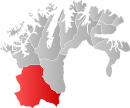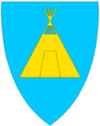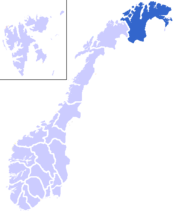Kautokeino
| Guovdageainnu suohkan Kautokeino kommune |
|||
| — Municipality — | |||
|
|||
 |
|||
| Coordinates: | |||
| Country | Norway | ||
|---|---|---|---|
| County | Finnmark | ||
| Municipality ID | NO-2011 | ||
| Administrative centre | Kautokeino | ||
| Government | |||
| - Mayor (2004) | Klemet Erland Hætta (Sami People's Party) | ||
| Area (Nr. 1 in Norway) | |||
| - Total | 9,708 km² (3,748.3 sq mi) | ||
| - Land | 8,964 km² (3,461 sq mi) | ||
| Population (2008) | |||
| - Total | 2,947 | ||
| - Density | 0.3/km² (0.8/sq mi) | ||
| - Change (10 years) | -6.1 % | ||
| - Rank in Norway | 273 | ||
| Time zone | CET (UTC+1) | ||
| - Summer (DST) | CEST (UTC+2) | ||
| Official language form | Bokmål and Sami | ||
|
|
|||
| Website: www.kautokeino.kommune.no | |||
Kautokeino (Norwegian) or Guovdageaidnu (Sami language), (Koutokeino in Finnish language) is a municipality in the county of Finnmark, Norway. The administration is located in the township of Guovdageaidnu/ Kautokeino.
The municipality was part of the old Kistrand municipality until 1851. The name of the municipality was Kautokeino until 1987 when it was changed to Guovdageaidnu-Kautokeino [1]. It was the first municipality in Norway to get a Sami name. In 2005 the name was again changed, such that the either Guovdageaidnu or Kautokeino can be used [2]
Guovdageaidnu/ Kautokeino is one of two the cultural centers of Northern Sápmi today (other being Karasjok). The most significant industries are reindeer herding, theatre/movie industry, and the public education system.
For the last couple of years, Kautokeino has been plagued by high rates of unemployment, peaking at 10% in 2006/2007. [3]
In the township of Guovdageaidnu (Kautokeino) live about 2000 of the 3000 people in the municipality. The village of Máze has 400 people, while the remaining live in 14 smaller villages. Recently the population has increased about 80 people each year. Guovdageaidnu/ Kautokeino has different demographics than the county of Finnmark and Norway, in that more than 50% of the population is younger than 30 years. Also, the number of people older than 66 years is half of the national average. [4]
Contents |
The name
The first element in Guovdageaidnu is guovda 'middle; half', the last element is geaidnu 'road'. Combined it means 'half way', as the location is half way between two traditional migrating points. It is also the geographic centre of Northern Sápmi. Kautokeino is a Norwegianized form of the Sámi name Guovdageaidnu.
Coat-of-arms
The coat-of-arms is from modern times (1987). It shows a lavvu.
Geography
Guovdageaidnu/ Kautokeino is the southernmost municipality of Finnmark and shares border with Alta, Norway to the north, Karasjok to the east, Nordreisa and Kvænangen in Troms county to the west, and Enontekiö in Finland to the south.
At 9704 km², it is the largest municipality in Norway. A total of approximately 10,000 lakes cover 640 km². A significant part of Finnmarksvidda (Finnmark plateau) is located in Kautokeino municipality. Gender ratio amounts to 86 women for every 100 men. More than 50% of the population is less than 30 years old.
The Guovdageaidnu-Kautokeino River runs from a lake at the Finnish border, north through the townships of Guovdageaidnu (Kautokeino) and Máze before it leaves into Alta municipality and changes name to Altaelva. The river is collectively known as the Kautokeino/Alta-vassdraget and was the site of a major political controversy in the late 1970s and early 80s.
Villages
In addition to the township of Guovdageaidnu (Kautokeino) the county has 15 smaller villages:
Máze (Masi)
Máze (Masi) is the largest of the villages. Máze is located in a river valley. There is a school and a church located in Máze. The current church has 150 seats was built of wood in 1965. The first chapel was built in the 17th century. The second by Thomas von Westen in 1721. This church was burnt during World War II in 1944. It was the site of a major political controversy in the late 1970s and early 80s, when it was proposed to flood village to build a large hydro-electrical dam.
Láhpoluoppal
Láhpoluoppal is a village located north-east of Guovdageaidnu at the Láhppojávri lake. The village has a school, chapel and mountain hut (fjellstue). The chapel has 70 seats and was built in 1967.
Šihččajávri
Šihččajávri is located south-east of Guovdageaidnu (Kautokeino). The Norwegian Meteorological Institute has a weather observation station in the village, and often the place has the lowest temperature in Norway.
Ávži
Ávži a village 10 km east of Guovdageaidnu. During the Kautokeino-rebellion the group of Samis that captured the rebellions was organized here.
Siebe
Siebe a village south of Guovdageaidnu.
Mieron
Mieron is a village north of Guovdageaidnu. Many of the Samis who traveled to Canada to teach the Inuit about reindeer herding were from Mieron.
Stornes
Stornes a village north of Guovdageaidnu. Close to Stornes is a slate field with distinct green quartzite marketed as Naranas.

Šjuoššjávri
Šjuoššjávri is a village north-east of Guovdageaidnu at the county-border to Karasjok with a chapel and a mountain hut. The chapel was built in 1968 and has 75 seats.
Čunovuohppi
Čunovuohppi is a small village with few houses and is 11 km west of Guovdageaidnu. The village has a mountain hut (staffed by Madame Bongo).
Suolovuopmi
Soulovuopmi north of Guovdageaidnu at the county-border to Alta. The location of a mountain hut, and for metrological observations.
Gálaniitu
Gálaniitu is south-west of Guovdageaidnu and has a mountain hut.
Áidejávri
Áidejávri is south of Guovdageaidnu close to the Finnish border.
Ákšomuotki (Økseidet)
Ákšomuotki (Økseidet) is south of Guovdageaidnu.
Soahtefielbma
Soahtefielbma is about 10 km west of Guovdageaidnu.
Birdlife
Lying south in the county, and bordering with Finland, Guovdageaidnu/ Kautokeino has a very interesting birdlife. There are virtually thousands of lakes in the municipality, and these combined with the Alta waterway system provide habitats for a whole host of wetland species. Whooper Swan can sometimes be found while Spotted Redshank are not uncommon.
Climate
Guovdageaidnu-Kautokeino is located in the Arctic highlands of Northern Norway. During five weeks of summer, the sun doesn't set, and during six weeks of winter, the sun doesn't rise.
Average precipitation is 360 mm/year, which is one of the lowest precipitation in the country. It is also claimed that this is comparable to parts of the Sahara desert, with the major difference being that with the lower temperatures and greater vegetation, Kautokeino doesn't dry up as fast.
During summer, temperatures typically range between 12 and 25 °C. While this is nice for humans, the temperature, combined with 10,000 lakes, makes it a haven for mosquitos. Consequently, both humans and reindeer tend to flee to the coast for the summer. Sihcjavri in Guovdageaidnu-Kautokeino municipality has recorded the warmest temperature ever in Northern Norway: 34.3°C on June 23 1920.
While winter usually lasts from mid-October till mid-May, the hard winter is only for December-February. During hard winter, temperatures can drop as far as -45 °C and beyond. The yearly average temperature over the last 30 years is -2.7 °C.
The dry climate, however, makes the cold temperatures more bearable; -12 °C in Guovdageaidnu-Kautokeino feels the same way as 0 °C feels on the coast. The dryness combined with cold also makes Guovdageaidnu-Kautokeino a prime spot to watch the Aurora Borealis.
Institutions and media
Several Sámi institutions are located in Guovdageaidnu/ Kautokeino, including:
- Beaivváš Sámi Theatre. The National Sámi Theatre. As a national stage company, they play a major role in making Sámi history and culture visible.
- Sámi Joatkkaskuvla ja Boazodoalloskuvla is the Sámi High School and Reindeer Herding School. The high school has emphasis on Sámi, rather than Norwegian culture. Most teachers speak Sámi as their mother tongue allowing for classes to be taught in Sámi. In addition to ordinary courses, students can also study duodji (traditional Sámi crafts) and reindeer herding. In fact, it is the only high school in the world that features a reindeer herding class.
- Sámi allaskuvla - the Sámi University College. The College has national responsibility for Sámi higher education, including teacher-, and journalist-training. The college attempts to develop the syllabuses on the basis of Sámi needs, and attempts to develop Sámi as an academic language.
- Nordic Sámi Institute. The Nordic Sámi Institute is a Sámi research institution. Research topics include the Sámi language, culture, reindeer husbandry and legal research. The institute published the DIEĐUT magazine.
- Sámi giellaossodat; The department of language at the Norwegian Sami Parliament. This department is the administration for the Sámi language board, it allocates the extra funding given to the municipalities that have Sámi as an official language (like Guovdageaidnu-Kautokeino), and it administrates various projects related to Sámi languages.
- The department of education at the Norwegian Sami Parliament.
The Sámi are also internationally active with regards to indigenous people issues and reindeer husbandry. Therefore, the following institutions are also located in Guovdageaidnu/ Kautokeino:
- Resource Centre for the Rights of Indigenous Peoples. The center attempts to collect, organize, and disseminate the knowledge and understanding of indigenous peoples’ and Sami peoples’ rights.
- International Centre For Reindeer Husbandry.
Guovdageaidnu/ Kautokeino is home to the following Sami media companies:
- Áššu a Sami language newspaper.
- DAT Sami publishing house and record company.
Cultural events
Guovdageaidnu-Kautokeino is perhaps the cultural center of Northern Sápmi today, and hosts several of he most well known Sami cultural events. The biggest event is the Sámi Easter Festival. Easter has traditionally been the time when the Sámis gather to celebrate weddings and confirmations. Today, also the Sami culture is celebrated with many yoik concerts, Sami theater shows, reindeer races, snowmobile races, ice fishing competitions, parties, and the Sámi Melody Grand Prix; a Sámi version of the Eurovision Song Contest where in addition to the best song, the best yoik is also selected. In addition, the Sami Film Festival is usually held during the Easter, which is notable for having an outdoor cinema made of snow [5].
In June, the annual Guovdageaidnu/ Kautokeino Walk / Bicycle Ride, has Sámis return to Guovdageaidnu-Kautokeino, just to walk a few kilometers, or ride a bicycle for twice the distance.
In August, there is the White Fish festival, as well as the Autumn Festival. The latter is a weekend-long party full of concerts, but also includes Snowmobile races on the (unfrozen) river. If you go too slow or make too sharp a turn, the snowmobile will sink.
Notable people from Guovdageaidnu/ Kautokeino
- Ole Henrik Magga - the first president of the Sami Parliament of Norway and currently the president of the UN permanent forum for indigenous people.
- Ingor Ante Ante Mihkkal Gaup - Joiker
- Ingor Ánte Áilo Gaup (Iŋgor Ántte Áilu Gaup) - Musician and actor
- Niko Valkeapää - Musician, winner of the Norwegian Spelemannsprisen in 2004. (Originally from Finland, but he lives in Kautokeino.)
- Nils Gaup - director who earned an Academy Award Nomination for his movie "Pathfinder"
- Håvard Klemetsen - a nordic combined skier with a gold and bronze team medals at the FIS Nordic World Ski Championships.
External links
- Kautokeino Municipality Official Website
- Destinasjon Kautokeino Tourist office
- Kautokeino.Com is the major online "meeting point" (mostly Norwegian and Sámi)
- Sámi Joatkkaskuvla ja Boazodoalloskuvla
- Sámi University College
- Beaivvas Sámi Teahter
- kautokeino.net News and information about events in Kautokeino
References
- ↑ Ot.prp. nr. 111 (2001-2002) - regjeringen.no
- ↑ <dato>FOR-2004-12-10-1636</dato> Endring av skrivemåten for tospråklige kommuner. Endring av skrivemåten for tospråklige kommunenavn, Deatnu-Tana, Gáivuotna-Kåfjord, Guovdageaidnu-Kautokeino, Kárášjohka-Karasjok og Unjárga-Nesseby, Troms og Finnmark
- ↑ Finnmarkstatistikken: Yrkesdeltaking 2006
- ↑ Kautokeino kommune
- ↑ http://news.bbc.co.uk/2/hi/entertainment/3603665.stm>
|
|||||

